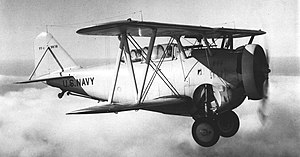Grumman FF-1
| FF / SF "Fifi" | |
|---|---|
 |
|
| Role | Naval fighter |
| Manufacturer | Grumman |
| Designer | Leroy Grumman |
| First flight | 29 December 1931 |
| Introduction | June 1933 |
| Retired | 1940 |
| Primary users |
United States Navy Spanish Republican Air Force Royal Canadian Air Force |
| Produced | 1932-1934 |
| Number built | 116 |
| Developed into | Grumman XSBF |
The Grumman FF "Fifi" (company designation G-5) was an American biplane fighter aircraft operated by the United States Navy during the 1930s. It was the first carrier aircraft with retractable landing gear. It was produced under licence in Canada and known as the Goblin in Canadian service and Delfin (en:Dolphin) in Spanish service.
The FF-1 was Grumman’s first complete aircraft design for the US Navy. The Navy had asked Grumman if their retractable landing gear made for the O2U-1 Scout planes could be retrofitted to the Navy's Boeing F4B-1 fighters; instead Grumman proposed a new fighter design. The prototype XFF-1 (serial number A8878) was built to a contract placed on 22 April 1931, first flying on 29 December of that year, a two-seat design, with an enclosed cockpit, fuselage of all-metal construction, and wings covered largely with fabric. The XFF-1 was powered initially by a 616 hp (459 kW) Wright R-1820-E Cyclone radial engine, it achieved 195 mph (314 km/h) during service trials. Later the original engine was exchanged for a 750 hp (560 kW) Wright R-1820-F Cyclone and the XFF-1 reached a top speed of 201 mph (323 km/h), faster than any US Navy fighter in service at the time.
A production order was placed for 27 two-seat FF-1 (G-5) on 19 December 1932. Meanwhile Grumman had completed a second prototype (serial number A8940) to a two-seat scout configuration as the XSF-1 (G-6). Subsequently 33 production SF-1s were ordered based on the two-seat configuration. They differed from the FF-1 principally in having revised internal equipment and in being powered by R-1820-84 Cyclones instead of the R-1820-78 model installed in the fighter version. One XSF-2 was also completed, this having a Pratt & Whitney R-1830 Wasp engine in place of the Cyclone.
FF-1s were delivered to Fighter Squadron VF-5B of the USS Lexington beginning in June 1933. In service the FF-1 became familiarly known as the "Fifi". Delivery of SF-1s started on 30 March 1934, and they also served aboard the Lexington, with Scout Squadron VS-3B.
Both the FF-1 and SF-1 were withdrawn from first-line US Navy squadrons by the end of 1936 and reallocated to reserve units, most of the FF-1s still being in service late in 1940. Later, 22 surviving FF-1s were modified with dual controls, redesignated FF-2 and used for instructional duties.
...
Wikipedia
